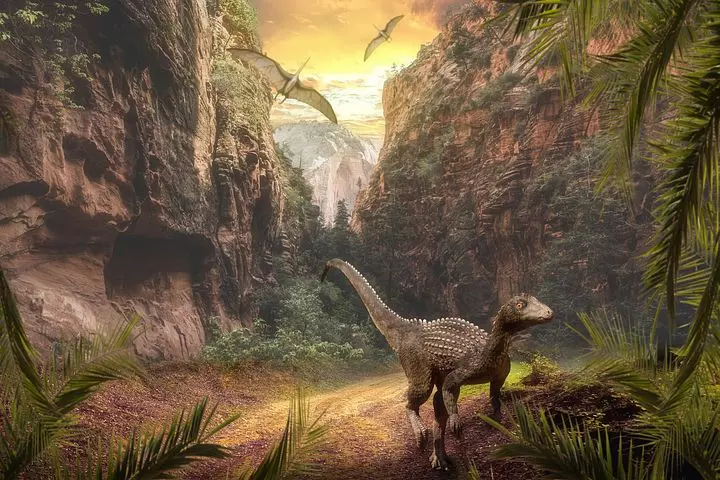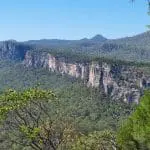[Originally published as the first part of Dinosaurs: A Biblical Creation and Flood Perspective]
The common thread running through these diverse cultural stories is the portrayal of reptilian giants — creatures that evoke both fear and reverence. From a biblical creation perspective, these legends might not be mere folklore but preserved memories of real-life encounters.
Walking in the Footsteps of Giants
Have you ever marveled at the sheer scale and mystery of dinosaurs? These magnificent creatures, which have captured our imaginations for generations, are not just relics of an ancient past but integral characters in history. From their appearance on Day 6 of Creation to their dramatic preservation during the Flood — and even to modern discoveries that challenge conventional timelines — dinosaurs invite us to explore science, Scripture, and the awe-inspiring creativity of our Creator.
Dinosaurs in the Bible
In the biblical account found in Genesis 1:24–25, God’s creative work culminated on Day 6 with the creation of all land-dwelling animals and man.
Imagine a freshly formed earth where the Creator fashioned not only every kind of animal we see today but also incredible giants — the dinosaurs. These creatures, ranging from towering sauropods to swift, agile theropods, were part of God’s “very good” creation in the beginning. However, after the Fall of man, sin entered the world through Adam and Eve’s disobedience in eating the forbidden fruit, and the Bible tells us that all flesh became corrupted and violent as a result.
This violence was not just committed by mankind, but all of God’s creation that was placed under the care and authority of mankind — including the dinosaurs. As a result of that growing wickedness, God sent the Flood in Noah’s day.
The dramatic events of the Flood, described in Genesis 6–8, offer a powerful explanation for the burial and fossilization of many living creatures, including dinosaurs. As the waters rose and submerged the earth, rapid sedimentation occurred as sand, mud, and debris from the destroyed pre-Flood world were carried hundreds to thousands of miles by massive tsunami-like waves and high-speed currents, burying the remnants of that ancient landscape.
This sudden covering of life not only wiped out entire ecosystems and all land-based, air-breathing animals (except those on Noah’s Ark) but also set the stage for fossil formation.
Noah was commanded to take “two of every kind” aboard the Ark — a term best understood as referring to a broader classification, similar to the modern concept of an animal family. This means that while many individual species did not survive, the genetic potential for family “kinds” was preserved, allowing for the diversity of life we see today. Mass burial sites, such as those at Dinosaur National Monument and the Coelophysis quarry at Ghost Ranch in New Mexico, serve as impressive reminders of that cataclysmic event.
While the Flood was undeniably destructive, the biblical narrative suggests that not all dinosaurs vanished immediately.
The book of Job, written in a post-Flood era between Noah and Abraham, introduces us to a creature known as “behemoth” (Job 40:15–24). Described as a mighty, plant-eating beast with strength in its loins and a tail “like a cedar,” many creation researchers believe that Behemoth could very well be a sauropod dinosaur. This interpretation hints at a time when humans and dinosaurs coexisted — a fascinating possibility that invites us to reconsider our assumptions about the timeline of life on earth.
Global Legends: Dragons as Living Memories of Dinosaurs?
Across the globe, cultures from every corner of history have preserved captivating legends of dragons and enormous reptilian creatures. These stories, rich with detail and often surrounded by awe and fear, have been handed down through generations. They feature fire-breathing monsters, winged serpents, and massive water-dwelling beasts — descriptions that bear uncanny similarities to what we now understand about dinosaurs and other large creatures in the past.
Could these tales hold more than just flights of imagination? Could they represent actual encounters with creatures from God’s creation that we no longer see today?
In medieval Europe, dragons dominate the tales of knights, villages, and even the margins of illuminated manuscripts. These creatures were often described as reptilian, enormous, and incredibly powerful. Some accounts even described their ability to breathe fire — a trait that might seem fantastical but could easily have been an embellishment or even conflating with other creatures, like the biblical leviathan.
While modern science views dragons as mythological, these detailed and widespread stories raise the question: Were they based on something real that people once saw?
Moving beyond Europe, we find similar creatures in the legends of ancient China. In Chinese culture, their serpentine bodies and scale-covered forms share a strong resemblance to certain dinosaur species. The fact that these creatures are so central to Chinese art, philosophy, and literature suggests that they played a significant role in the cultural memory of ancient peoples — perhaps even reflecting real encounters with dinosaurs or similar creatures.
Marco Polo, the renowned Venetian explorer, traveled extensively in China during the late 13th century. In his accounts, he described encountering large serpentine creatures that closely resemble traditional dragon depictions. He detailed these creatures as having enormous bodies, two short forelegs near the front, and formidable claws. Polo’s descriptions align with many dragon legends from the Far East, yet he presented them in a straightforward manner, suggesting he perceived them as real animals rather than mythical beings.
In Central Africa, the story of Mokele-mbembe adds a fascinating dimension to this discussion. Described as a large, long-necked creature resembling a sauropod dinosaur, Mokele-mbembe is said to inhabit the dense swamps of the Congo Basin. Over the years, explorers and locals have shared strikingly consistent accounts of this mysterious beast.
Although no definitive evidence has yet been found to prove its existence, the persistence of the legend raises compelling questions. Could this creature represent a remnant population of dinosaurs that survived into modern times, as some have suggested?
These dragon-like legends are not confined to Europe, Asia, or Africa. Native American tribes tell of Thunderbird-like creatures, sometimes described or depicted as reptiles with wings, believed to have inhabited the skies and cliffs of North America. Similarly, the Aboriginal peoples of Australia recount tales of enormous reptiles, some of which match descriptions of prehistoric creatures like theropods or pterosaurs. Even the ancient Mesopotamians and their myths of serpent-like monsters, such as Tiamat, bear a striking resemblance to the forms and features of dinosaurs.
The common thread running through these diverse cultural stories is the portrayal of reptilian giants — creatures that evoke both fear and reverence. From a biblical creation perspective, these legends might not be mere folklore but preserved memories of real-life encounters.
After the Flood, if dinosaurs survived and coexisted with early human civilizations for some time, it’s entirely plausible that these interactions left a lasting mark. Early humans, without the tools of modern science, would have interpreted these creatures in ways that fit their worldview, imbuing them with mythical or divine qualities. Over time, these encounters could have been exaggerated into the legends we now know.







